 |
 |
 |
 |
 |
 |
 |
 |
 |
 |
 |
 |
 |
 |
 |
 |
 |
|
 |
 |
 |
|
 |
 |
 |
|
 |
 |
 |
Grateful thanks to all those that have provided many of the articles, references and details in these pages
This is a non-profit site |
| |
| |
| |
| |
| |
| |
| |
|
 |
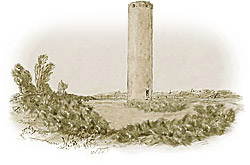 |
|
 |
 |
Craig's telescope around 1870
courtesy Corporation of London © |
|
 |
 |
The Telescope's Demise
Picking through archive files can be an extremely lengthy business, especially if you do not know exactly what it is you are looking for.
Finding the truth behind the demise of Craig's telescope certainly has been a long haul, but time has paid dividends.
We have already established that the instrument was loved by no one. Craig's wish for it to be taken to heart by every aspiring astronomer and scientist, proved unfulfilled. Gravatt's engineering skills were all in vane as he worked against a tide of opinionated misconceptions and direction as well as a lack of funds. The instrument was a great disappointment to all those who had spent so much time on it. After only a few years of desperate cajoling, trying to manage a work around so that some kind of scientific study could be undertaken, the telescope was abandoned.
So what do we know of the observatory's last years, standing isolated on a part of the Wandsworth Common that was coming under scrutiny from the community, local committee members and members of Parliament?
We know that by about 1856 (maybe 1858) the last attempts to do any science with the instrument had run its full course. Craig had already returned to Leamington, vowing never again to set foot in Wandsworth. So much investment both in time and money had been extremely telling on Craig, especially when several members of his closest family including his wife and only son had died in the years the telescope was being put through its paces.

During the first months of operation the telescope was considered by some to be worthy of merit. The Leamington Courier notes that, "Whether the gentleman, to whom the public were already so much indebted, would go still further and appoint an astronomer to reside upon Wandsworth Common, or whether the Government would take upon itself to endow the Craig telescope, and appoint a professor with a salary". Despite propositions of the like, the observatory never acquired its site manager.
back to top of page >>
1857 - the beginning of the end
The death of the 4th Earl Spencer in 1857, donator of the 2 acre site, must have played a part in the observatory's end.
|
 |
|
In the same year the Scottish physicist, James Clerk Maxwell, proves mathematically that Saturn's rings are composed of many small bodies orbiting the planet. George Bond in the United States, becomes the first to photograph a double star, Mizar, and obtain images of both components; and with the advent of silver-coated glass telescope mirrors replacing metal mirrors used in previous reflecting telescopes as devised by Léon Foucault, the Craig Telescope had met its match and interest in it faded.
Inevitably, the project was dropped. It was decided to sell off as much of the instrument as possible for scrap. This in itself was rye irony, for despite it being such a failure much of the telescope's parts were "re-cycled" in the renewed development of the Wandsworth area.
Details of the demolition are few and far between. Newspaper articles and reports make light of its final days perhaps because it had not gained a reputation as a world class instrument.
In an extract from the History of the Telescope by Henry C King we read, "The crude structure was dismantled after a few years' use, but not before it had formed a strange landmark for the residents of Wandsworth…". King is particularly slight in his narrative regarding the telescope, biased maybe by the feelings of the scientific community.
back to top of page >>
Mr Edward Walford writes in a popular London guidebook, Old and New London in 1897, "At a short distance south of the prison, forming a conspicuous object to passengers travelling on the South-Western main line, or the Crystal Palace and West-end Railway, stood for several years the Craig Telescope… Not fulfilling the original expectations of its proprietor, the instrument was some years ago dismantled and removed."
 |
 |
 |
 |
 |
 |
| |
The bricks were employed to aid in the erection of an hotel visible a few hundred yards off |
 |
 |
 |
 |
 |
 |
There are a number of little snippets in various publications and journals of the time that give some vague outlines as to how the observatory was dismantled and what became of the various parts. In an article written by a popular contributor, Mr Edward Crook, about a walk in and around the Wandsworth and Putney area published in the Wandsworth Borough News in 1935, he mentions, "I fear the promoter was ruined; it fell into disrepair, and the last I saw of it was the telescope in sections among a lot of building lumber in a builder's store-yard in the Wimbledon Park-road in the early eighties. The tower disappeared, and the ground again became part of the Common." Mr Crook saw that at least some parts had been taken by an enterprising business, but exactly which parts? Although it implies wooden sections, it could just as easily be other materials as well - could he mean also parts of the telescope tube?
The bricks of the tower and no doubt all those of the outhouses on the site, must have been seen by those developing the southern part of the common as spoils that could easily be put to good use by the many building projects under way in the 1860s.
The best description concerning the dismantling and distribution of the various parts of the telescope comes in an extract from The English Mechanic of May 1870, by E. Salter. He wrote, "Having recently come to reside in this locality (Clapham Junction), and noticing Mr. Webb's late remarks respecting the great Wandsworth Telescope, I have been induced to try and seek it out. After two or three failures I met near the spot on which it used to stand a gentleman named Stilwell, an inhabitant of Wandsworth, who gave me the following particulars from his own personal knowledge.
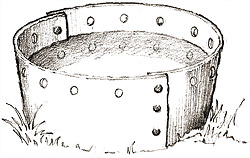 Pointing out the enclosure within which the instrument was erected, and indicating markings in the ground left by the tower from which it swung, he said that the whole affair was removed four or five years ago. The bricks were employed to aid in the erection of an [sic] hotel visible a few hundred yards off; the tube was bought by a Wandsworth broken [sic], who cut it into sections, and sold them to a gentleman at Wimbledon. These sections, with bottoms inverted, formed tanks, from which the gentleman's cattle now drink. About the tramway there was some four tons of wrought iron, which Mr, Stilwell himself had converted into horse-shoes. As to the object glass, my informant could tell me nothing." Pointing out the enclosure within which the instrument was erected, and indicating markings in the ground left by the tower from which it swung, he said that the whole affair was removed four or five years ago. The bricks were employed to aid in the erection of an [sic] hotel visible a few hundred yards off; the tube was bought by a Wandsworth broken [sic], who cut it into sections, and sold them to a gentleman at Wimbledon. These sections, with bottoms inverted, formed tanks, from which the gentleman's cattle now drink. About the tramway there was some four tons of wrought iron, which Mr, Stilwell himself had converted into horse-shoes. As to the object glass, my informant could tell me nothing."
back to top of page >>
The Brickwork
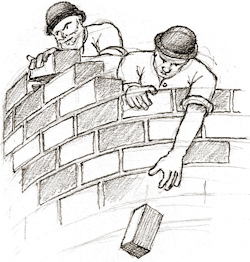 |
|
 |
 |
Demolition during the late 1800s was a careful affair as there was always an opportunity to employ the second hand bricks in other building projects, as proved to be the case with the Craig Telescope.
Courtesy Greg Smye-Rumsby |
|
 |
 |
The information above was used as a guide for another visual survey of the area in the in the spring of 2005. It was hoped that, just maybe, the original distinctive red bricks of the central tower were re-used locally and could be seen today in the brickwork of one or two of the many buildings surrounding that part of the common. It was a task which at first was thought would be difficult, at best. What if the the re-used bricks were incorporated into internal walls, invisible to the outside world, prevented from spoiling the look of an otherwise attractive facade. Given that the abstract refers to a hotel within sight of the original tower, there was only one possible candidate with the right credentials, the Surrey Tavern at the junction of Trinity and Belvue Roads. The County Arms, at similar distance to the north, was built at a slightly later date.
The task of those involved with the Craig Telescope project was much easier than could have been imagined. On driving up to the common along Trinity Road from the south to the traffic lights at Belvue Road, Rachel, a project member, immediately noticed the walls of the old Surrey Tavern - a section where it was clear a different stock had been used to complete the outer wall!
By comparing the brickwork for texture and colour on that bright sunny day with a sample brick retrieved from the Big Dig of 2003, it was clear we had found the remains of Craig's telescope. Today, even a cursory look at the outer walls of the building show the sharp line between the bricks used in the original construction of the hotel and those from the tower. One other interesting detail, the bricks are laid in the same flemish bond as when used on the tower.
The Surrey Tavern was built around 1864, obtaining its license in 1865, fitting perfectly with the evidence. But why build in such a strange way - adding old brickwork to new? Possibly, work on the Surrey Tavern had already commenced when an opportunistic foreman noticed the tower being dismantled only few hundred yards off to the north east. Today, the Surrey Tavern is no longer a hotel or public house but a modern apartment block with a restaurant covering the ground floor.
back to top of page >>
|  |
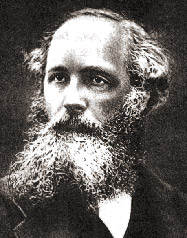 |
 |
| James Clerk Maxwell discovered the true nature of Saturn's rings. |
 |
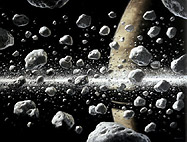 |
 |
Ludek Pesek's 'In Saturn's rings'.
Courtesy Geneva Observatory |
 |
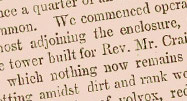 |
 |
More confusion about the exact timeline of the telescope's demise. An extract from Hardwick's Science Gossip for 1866, "...adjoining the enclosure, where once stood the tower built for Rev. Mr Craig's large telescope, of which nothing now remains but its rusty tube, rotting amidst dirt and rank weeds". Even allowing for delays in publishing from the time of the report it does seem that the tower was already gone by 1866.
Courtesy Hardwick's Science Gossip |
| |
| |
|
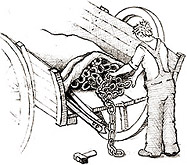 Mr James Robert Stilwell also mentioned in this text reveals much about the local commerce of the time. He lived with his family at 49 South Street, now part of Garratt Lane, Wandsworth. He was a farrier, shoeing horses for the local community and for the many mills and businesses along the Wandle River nearby. Mr James Robert Stilwell also mentioned in this text reveals much about the local commerce of the time. He lived with his family at 49 South Street, now part of Garratt Lane, Wandsworth. He was a farrier, shoeing horses for the local community and for the many mills and businesses along the Wandle River nearby.
He must have known first hand of the Craig Telescope although he was only a boy when it was erected. He took an interest in it and may have visited the site a number of times. By 1865 he would have realised the end was in sight, and although still quite young, Stilwell was a true entrepreneur, taking any opportunity to make a quick buck. His offer for the 4-tons of wrought iron scrap of the "tramway" was accepted by those now managing the disposal of the site. Converting the iron to horseshoes would have made him quite a handsome profit.
There are other references as to the possible whereabouts of some of the other components of the original telescope. In the Leamington Courier of 2 November 1906, it states, "There is reason to believe that the tube, or some portions of it were packed and sent to Leamington, as a burgess now living, who was intimate with Mr Craig in the old days informs the writer that he remembered seeing on the Vicar's premises a very large wooden arrangement, which might have been used as a packing case for parts of the instrument, but that Mr Craig never mentioned it, or attempted to explain its presence."
|
 |
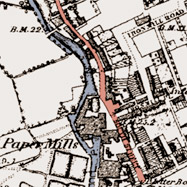 |
 |
| Part of north Wandsworth it is here that James Stilwell lived a short distance from the Craig Telescope. The blue line is the River Wandle while the red line is South Street which today is known as Garratt Lane. |
 |
|
The exact date when the telescope was demolished is confused by some texts. Firstly, in another extract from the Leamington Courier of 2 November 1906, it mentions a letter written by Craig from his hotel in Euston, London, to "an esteemed parishioner" on 21 September 1871, in which he writes, "What about my telescope? - I can afford to do without your money - and would like you somehow to have the use of it, a token of real regard, for I believe it would delight you and your family, just to see the moon even in it." Craig could simply be revealing his bitterness, citing the project as a particular point of personal soreness and disappointment. The extract implies that his poor business acumen has been questioned too many times. Indeed, he goes on by saying, "I have become so thick in the skin as to lies, I heed not their authors any more than the rats that fight over the garbage of the Priory sewers".
back to top of page >>
|
 |
A poem about Craig's feelings of the telescope and how he feels others had chosen to mock it >> |
Secondly, while on a visit to Wandsworth Library a map with the title "IN PARLIMENT SESSION 1871. WANDSWORTH COMMON." was uncovered. On it many notes had been overwritten to indicate the present state of the common for the "Conservators" at the time. The map was drawn by Arthur Butler - Surveyor & Land Agent for the Parliamentary Agents, Dyson & Co of Westminster. One of the notes refers to the enclosure set aside for the telescope and in what year that piece of land was returned back to the common. It is most probable that here the map is only referring to the enclosure and its state of repair, the buildings and tower having been removed in 1865. We know from the several maps drawn up in the 1870s that the boundary of the site was still delineated.
On the Wandsworth Council's historical section of their website it mentions the concerns of the residents of Wandsworth over the state of the common towards the end of the 1860s, noting: "In May 1868 the Vicar of Battersea hosted a meeting of people seeking to rescue the common from incremental development by appealing to the Metropolitan Board of Works to take over responsibility for it under the Metropolitan Commons Act of 1866. This action did not succeed and in 1870 further meetings were held and a Common Defence Committee was formed. Adjoining owners had erected fences around Plough Green in an effort to assert his rights over the land and in April that year an attempt was made to remove them. This effort to keep Plough Green open was a tumultuous affair with crowds and bands.
Further meetings ensued and funds were raised. In July 1870 two members of the Preservation Society, Mr Buckmaster and Mr Ransome, petitioned the Lord Mayor to hold a public meeting, which he agreed to, attended by ten Members of Parliament. Resolutions of support for action to preserve the Common were made. Eventually Lord Spencer acceded to public pressure and offered to transfer the whole Common, minus the Black Sea, to the Defence Committee."
A similar testimony is revealed in the Wandsworth News-Letter of 20 July 1912. In it, it states, "When the question of preserving the Wandsworth Common as an open space for the people of London was under consideration, a large and influential meeting was held at the Mansion House in July, 1870. On that occasion a short history of the Common was given, and one of the speakers stated that: - ‘In 1852 about two acres of Wandsworth Common were enclosed for the purpose of erecting a telescope through which (he sarcastically added) ‘you can see nothing.' The man became a bankrupt, the bricks and telescope were sold, but the enclosure remains to this day, and in the language of the agents, ‘several after it.'"
Around 1890 some twenty years after the restoration of the common much of Lyford and Routh Road were developed with gable-ended detached and semi-detached housing.
back to top of page >>
|
 |
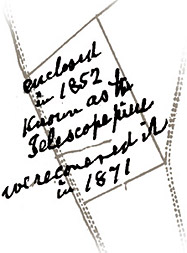 |
 |
A close up of the map "in Parliament session 1871". stating "enclosed in 1852. Known as the Telescope piece. we recovered it in 1871."
Courtesy Wandsworth Reference Library |
 |
|
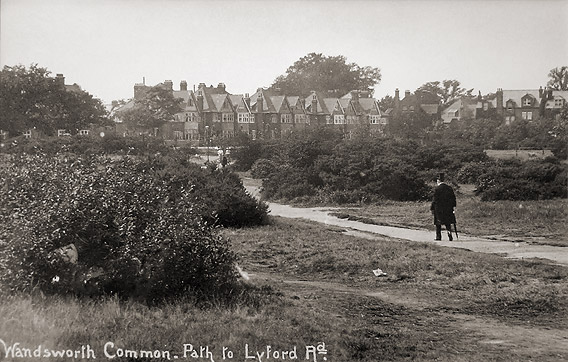 |
 |
Looking north west across the Wandsworth Common towards Lyford Road, this photograph was taken around 1890. The newly constructed houses in both Lyford and Routh Road show the recent development at that time. The path in the foreground is the same as that which runs across this part of the common today. Note the ever present rough grass and shrubbery.
 |
Bevington's detailed photograph of around 1855 gives the impression of dereliction, corroborating the suggestion that Craig and his colleagues were in trouble quite early on. There could not have been many more attempts at astronomy at the observatory and that its fate was sealed.
back to top of page >>
The Final Years
With these few pieces of evidence, it is now possible to sketch out the final years of the observatory's life.
In 1856, Craig and his colleagues decided to abandon the site. The most probable course of action from that moment on was to take all the smaller items of equipment, including books, charts, instrumentation, the finderscope and even the infamous 24-inch lens, leaving what seemed to an outsider a working observatory, complete with outhouses and telescope, the tube still in place on the side of the tower.
It is probable that this process may have taken some months.
What happened next is to some extent conjecture, but it is likely that the site was simply left virtually untouched, save for the action of vandals and opportunists up to no good while the observatory was unattended. During that time, and probably after quite some deliberation of the landowners, a committee, of which we know nothing, was set up to manage the disbursement of the site. Since Craig was now feeling so low about his life generally and had by now returned to Leamington, he was in no mood to think much about this particular problem, wishing that it would simply go away. But he did want some kind of return on his investment. Reluctantly he may have had something to do with the "disbursement committee".
So around 1857 to 1866 the "disbursement committee" began the task of selling off the various parts of the observatory recouping as much of the original costs as possible. The remarkably few finds excavated during the Big Dig of 2003, indicates their thoroughness. The tube was taken down along with its chainwork. This may have included the roof structure. The tube was then cut up into sections, perhaps for ease of sale or distribution. Some of these sections, with parts of the azimuth arm and possibly the chainwork were taken to a builders' supply yard in Wimbledon Park Road. Some sections were bought by a broker (although he may simply be the owner of the builders' supply yard), which in turn were sold on to a local farmer to provide water butts for his cattle. It also seems some were taken to the vicarage in Leamington. Only the inner and outer rails remained in place after this first period of sell-off, as these were most likely fixed firmly into the ground. We know that eventually even these were bought and removed by Mr Stilwell in 1864/5, melted down and turned into horseshoes!
Although there is no information about the out houses and accommodation block, these would have been seen, like the tower, as just more sundry building materials, sold to the highest bidder. It is likely, therefore, that their removal would have occurred at the same time as the tower. Perhaps, like the tower, the brickwork was incorporated in some of the buildings locally, although those in Lyford and Routh Road were not commenced until after 1890.
As for the lens whereabouts, we have as yet to find out.
back to top of page >>
A Problem Solved
During the Big Dig archeological excavation of the site in 2003, it was noticed how little evidence there was of demolition. The radar had shown only a vague imprint of the tower and virtually no outlines of pathways leading to or from the site during its use or its dismantling and removal. There was also a noticeable lack of staining from the mortar and rendering which would have fallen to the ground while each of the bricks was loosened from its position. It now seems that the passage of time from the last attempted operation of the telescope to its demise and the many projects to which the salvage had been applied had effectively prevented any pathways becoming established. Some parts would have been transported due north towards Wandsworth town centre while Mr Stilwell's ironwork, west, towards the Wandle River. The tower's brick, south, to be incorporated into the Surrey Tavern.
back to top of page >>
The Final Word
Let us leave the final word regarding the telescope to members of the Royal Society who were appropriately quoted in the Leamington Courier as having "frowned upon its birth".
back to top of page >> |
 |
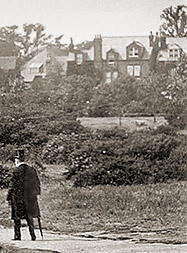 |
 |
| Detail of where the Craig Telescope once stood. Nothing seems to remain, not even the bounding fence. Geoffrey Bevington took his photograph of the telescope from a similar vantage point. |
 |
|
|

